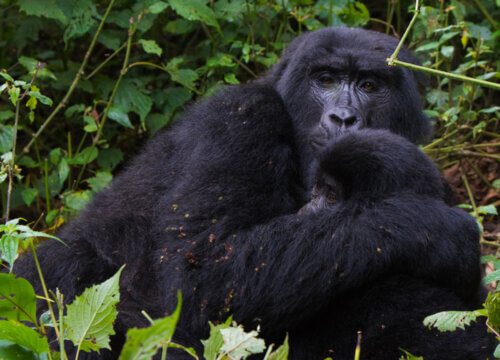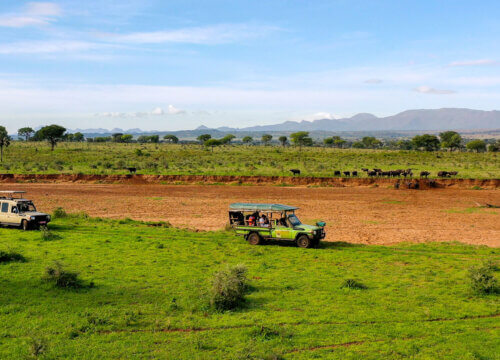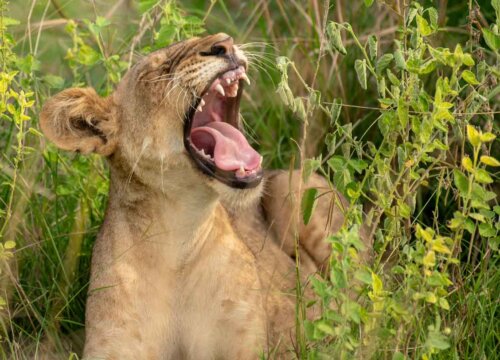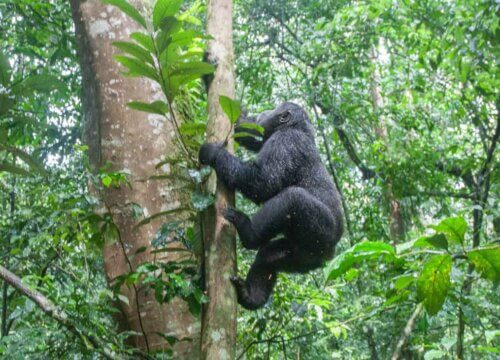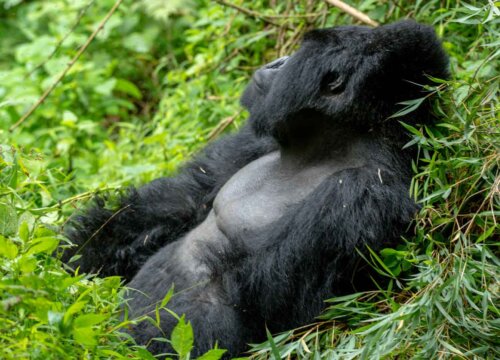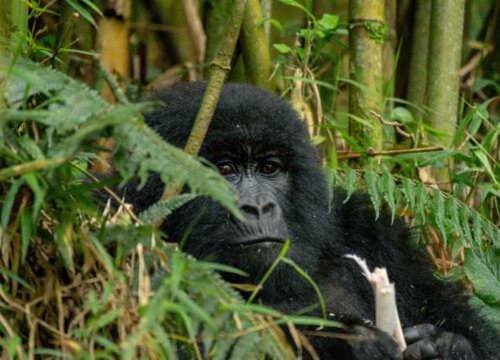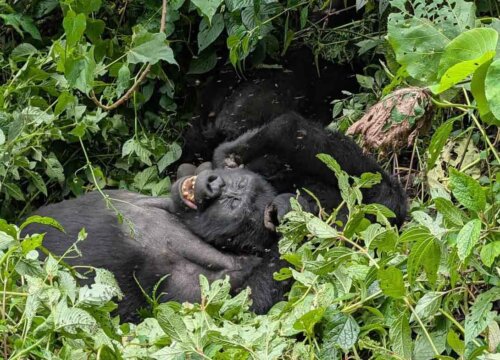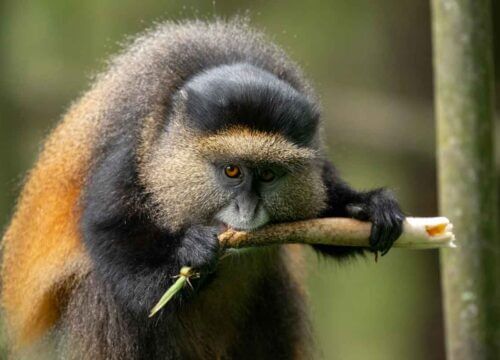About mountain gorillas
About mountain gorillas
Mountain gorillas are some of the most brilliant creatures on earth. They are found in the lush, misty forests of Central and East Africa primarily in the Virunga Mountains crossing Rwanda, Uganda and the Democratic Republic of Congo. Their striking appearance, soulful eyes and powerful yet peaceful demeanor make them a symbol of both strength and grace. Mountain gorillas are known for their thick, hairy fur which helps them stay warm in their cool homes. Adult male gorillas called silverbacks are particularly striking with a patch of silver hair running down their backs. They weigh up to 400 pounds and stand nearly 5 feet tall when upright. Living in family groups led by a dominant silverback, mountain gorillas are highly social animals. They spend their days hunting for leaves, fruits and bamboo plus resting in the shade. Their expressive faces, broad chests and playful behaviors make them attractive to watch but sadly, mountain gorillas are critically endangered due to habitat loss, poaching and diseases which has threatened their survival for years. However, thanks to dedicated conservation efforts and the hard work of local communities, their numbers are slowly increasing. Organizations around the world are working tirelessly to protect mountain gorillas and their habitats which gives hope for their future.
Visiting mountain gorillas in their natural homes is a life-changing experience for tourists who are fortunate enough to do so. Trekking through dense forests to watch them closer raises a deep appreciation for their beauty and the importance of preserving their environment. Mountain gorillas are more than just animals, they are a testament to the wonders of nature. Their resilience and beauty inspire us to care for our planet and all its residents. By supporting conservation efforts, we ensure that future generations will also have the chance to look at mountain gorillas.
Facts about mountain gorillas
- Mountain gorillas are one of the most extraordinary creatures of nature that capture the hearts of wildlife enthusiasts around the world. Mountain gorillas are found in only two regions that is the Virunga Mountains which cross Rwanda, Uganda and the Democratic Republic of Congo and Bwindi Impenetrable Forest in Uganda. Despite their limited range, their presence is huge in the animal kingdom.
- One of the most striking features of mountain gorillas is their size. Adult males known as silverbacks because of the distinctive silver hair on their backs, can weigh up to 430 pounds and stand over six feet tall when on two legs. Despite their imposing size, they are peaceful animals. Mountain gorillas live in family groups led by a dominant silverback who protects and guides the group which usually has many females and their offspring.
- Silverback mountain gorillas live for about 12 to 20 years with characteristics of being able to resolve conflicts, protect gorilla families from external threats and leading the group.
- Mountain gorillas are primarily herbivores that feed on diet rich in leaves, stems, fruits and bamboo shoots. They spend much of their day eating and hunting and resting in shades which helps sustain their large bodies. Interestingly, they rarely drink water because they get most of their hydration from the plants they eat.
- Mountain gorillas are intelligent and share about 98% of their DNA with humans. They communicate through a variety of vocalizations, body language and facial expressions. Watching them interact is a reminder of how closely connected we are to these primates.
- Unfortunately, mountain gorillas are critically endangered due to habitat loss, poaching and diseases. However, conservation efforts over the past few decades have made a significant impact. Organizations and governments have worked tirelessly to protect their habitats and promote eco-tourism which has provided funding for their preservation.
- Observing mountain gorillas in the wild is a rare experience for those lucky enough to visit their natural environment because they are a symbol of beauty of nature. For more details about mountain gorillas, visit our website at Giant Holiday Safaris.
Which kingdom do mountain gorillas belong?
Mountain gorillas are gentle and powerful giants that belong to the Animal kingdom of mammalia. This kingdom involves all animals from the tiniest insects to the largest mammals. They are a subspecies of the eastern gorilla which is scientifically known as Gorilla beringei beringei. As members of the Animal kingdom, mountain gorillas share certain characteristics with other animals like being multicellular, eukaryotic organisms that rely on consuming organic material for energy. Interestingly, mountain gorillas are highly social and live in caring groups led by a dominant silverback male. Their behavior and interactions with one another remind us of the deep connections we share with other species in the animal kingdom.
Where are mountain gorillas found?
Mountain gorillas live in specifically two main areas. These are the Virunga Mountains and Bwindi Impenetrable National Park. The Virunga Mountains stretch across three countries that is Rwanda, Uganda and the Democratic Republic of Congo while Bwindi Impenetrable National Park is located entirely in Uganda.
These regions are characterized by their dense forests, cool temperatures and high altitudes, ranging from 8,000 to 13,000 feet above the sea level. The thick vegetation provides mountain gorillas with plenty of food like leaves, stems, fruits and bamboo shoots. It also offers protection from predators and a place to live in harmony with their family groups.
Bwindi Impenetrable National Park and Mgahinga Gorilla National Park in Uganda are popular for their thriving gorilla population and beautiful scenery. Volcanoes National Park in Rwanda is also one of the most famous destinations for watching mountain gorillas. In addition, Virunga National Park in Democratic Republic of Congo also has a gorilla population. These places are known among ecotourists and conservationists who wish to witness mountain gorillas in their natural environment. Visiting these areas responsibly helps in supporting ongoing conservation programs and ensuring that mountain Gorillas continue to live for generations to come.
What are the current gorilla threats and conservation efforts?
Habitat loss is one of the biggest threats to gorilla populations. As human populations grow, forests are cleared for agriculture, logging and infrastructure development. This destruction of their natural habitat leaves gorillas with fewer places to live, feed and thrive. Additionally, illegal hunting and poaching remain significant dangers. Despite laws protecting gorillas, they are sometimes hunted for bushmeat or captured for the mysterious trade. Diseases are another major concern since mountain gorillas are closely related to humans which makes them vulnerable to many of the same illnesses. Diseases like Ebola, tuberculosis and influenza have distressed gorilla populations in the past wiping out entire groups in certain areas. Climate change also poses a growing threat because it disrupts ecosystems and reduces food availability in their homes.
Thankfully, there is hope for mountain gorillas because conservation organizations and local communities are working hard to protect them and their habitats. Anti-poaching patrols and stricter enforcement of wildlife protection laws have helped reduce illegal hunting in some regions. Efforts to create and expand protected areas such as national parks and reserves are also put in place to make sure that gorillas have safe spaces to live and walk around. Community involvement has also been key to conservation success. By educating local people about the importance of gorillas and providing alternative livelihoods like eco-tourism opportunities, communities are encouraged to protect these animals rather than exploit them. Gorilla trekking for example allows tourists to see mountain gorillas in their natural homes while contributing funds directly to conservation programs. In addition to these efforts, scientists and researchers are studying mountain gorillas to better understand their behavior, social structures and needs. This research helps inform conservation strategies and ensures that protective measures are as effective as possible. With continued support from governments, organizations and individuals around the world, we can help ensure a future where gorillas thrive in the wild. For more information about mountain gorilla conservation, please contact Giant Holiday Safaris.
How is the Mountain Gorilla trekking Adventure
Going on a mountain gorilla trekking adventure is a rare experience because they are found in only a few places on Earth like Uganda, Rwanda and the Democratic Republic of Congo. Mountain gorilla trekking is an exciting journey guided by experienced trackers. You will hike through dense vegetation, winding trails and sometimes steep terrain while searching for mountain gorillas. Once you find them, you are given an hour to watch them interacting, training, feeding, grooming each other or simply resting in the shade. At this point, you are allowed to take their videos and pictures using little or no flash light.
Mountain gorilla trekking is not just about adventure; it is also about conservation. Your visit directly supports efforts to protect these endangered animals and their environment. With fewer than 1,100 mountain gorillas left in the wild, every trekker contributes to their survival.
What is Dian Fossey’s research about mountain gorillas?
Dian Fossey is a name that resounds with compassion, dedication and a solid commitment to wildlife conservation. Known for her groundbreaking research on mountain gorillas, Fossey’s work has left a permanent mark on the world of primatology and environmental preservation.
Born in 1932 in San Francisco, Fossey initially pursued a career in occupational therapy before her love for animals led her to Africa. Inspired by the work of famed anthropologist Louis Leakey, she went on a journey that would change her life and the future of mountain gorillas. In 1967, she established the Karisoke Research Center in Rwanda found in the Virunga Mountains where she dedicated her life to studying and protecting these gentle animals.
Fossey’s research gave priceless insights into the behavior, social structure and ecology of mountain gorillas. She spent countless hours observing them in their natural home, often earning their trust by mimicking their vocalizations and movements. Her groundbreaking work revealed the deep emotional bonds within gorilla families and dispelled myths about their aggressive behavior.
However, Fossey’s work extended far beyond research. She became a fierce advocate for gorilla conservation, fighting against poaching and habitat destruction but she faced threats from poachers and even local opposition at times. Despite these obstacles, Fossey remained persistent in her mission to protect the mountain gorillas that she loved.
Her 1983 book called Gorillas in the Mist brought global attention to the plight of mountain gorillas and highlighted the urgent need for conservation efforts. sadly, Fossey died mysteriously in 1985 when she was found murdered at her research camp. Thanks to Dian Fossey’s tireless work, mountain gorilla populations have shown signs of recovery. Conservation organizations including the Dian Fossey Gorilla Fund, continue to carry forward her mission ensuring that mountain gorillas have a bright future.
Explorer More Safaris
- 14-Days Uganda Safari Gorilla Chimpanzees and Wildlife
- 12 Days Gorillas and Chimpanzees Wildlife Safari
- 10 days best of uganda primates & wildlife safari
- 6 Days Gorillas and Chimpanzee Trekking Safari
- 3 Day Bwindi Gorilla Trekking Safari
- 4 Day Uganda Gorilla Trekking and Wildlife Safari
- 4 Days Gorilla Trekking and Adventure Safari
- 5 Days Uganda Gorillas and Chimpanzee Tracking Safari
- 4-Day Rwanda Gorilla Trekking and Golden Monkey Tracking Safari
- 5 Day Gorilla Habituation and Chimp Trekking
- 4-Day Uganda & Rwanda Gorilla Trekking Tour
- 3 Days Bwindi Gorilla Trekking Ugnada from Rwanda
- 10 Days Uganda Primates and Game Safari

